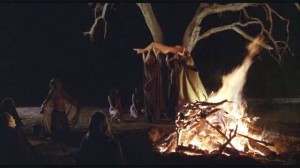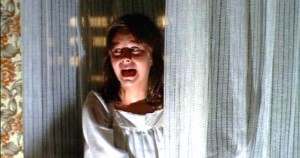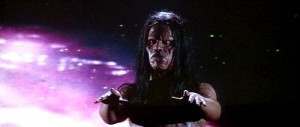
WILLIAM Friedkin’s The Exorcist — based on the best-selling novel by William Peter Blatty — quickly became one of the first genre blockbusters of the seventies, and a generational touchstone to boot.
The Exorcist also represented a new brand of horror film, in a sense, because it lacked a familiar “monster” like Dracula, the Wolf Man or The Frankenstein Monster, and it didn’t depend on well-known genre personalities, like Vincent Price, Christopher Lee, or Peter Cushing, either.
Accordingly, lines stretched around the block for showings of the horror film on the East and West coasts in America, and everyone seemed to have a very strong opinion about the controversial film, pro or con.
The Reverend Billy Graham, for instance reported that traumatized Exorcist viewers were experiencing “nightmares and problems they never had before.”
Graham’s publicly-expressed fear was that there would be even more psychological damage to Americans if people continued to “flock to the box office” to see The Exorcist.
But while such self-appointed protectors of morality wrung their hands over Friedkin’s masterpiece and its public acceptance, Hollywood filmmakers realized that a large audience was now primed for much more of The Exorcist’s brand of terror.
Specifically, this brand of horror consisted of “normal” Americans unexpectedly encountering the supernatural and/or paranormal, and in the process facing questions of the after-life, and the existence of God…or the Devil.
In the span of a few short years, movie audiences were treated to Exorcist imitations such as Abby (1974), Beyond the Door (1975), The Devil’s Rain (1975), Race with the Devil (1975), The Reincarnation of Peter Proud (1975), The Haunting of Julia (1976), Ruby (1977), and The Legacy (1979).
Below is a list of five of the best such Exorcist knock-offs, in chronological order. These inventive, well-made films — while no doubt inspired by The Exorcist — also expertly established their own unique and terrifying artistic identities.

Race with the Devil (1975)
Although Vincent Canby at The New York Times termed this film from director Jack Starrett a “ridiculous mish-mash of a movie for people who never grew up,” Race with the Devil nonetheless thrives as a kind of “Road Warrior meets Satan” masterpiece.
In keeping with the 1970s’ accent on materialism or conspicuous consumption, Race with the Devil sees Easy Rider (1969) star Peter Fonda turn in his motorcycle and counter-culture freedom for the luxury – and installment payments — of an elaborate, kitted up RV.
With his wife and another couple in tow, Fonda’s character, Roger, begins a vacation and once on the road in Texas stumbles upon a secret Satanic ritual.
In keeping with the immediate post-Watergate Scandal milieu, Roger discovers that the Satanists aren’t in it alone…but supported by the local government, including an evil Sheriff (jokingly named Taylor, as in Mayberry’s Andy Taylor…) played by the menacing R.G. Armstrong.
The rest of the movie takes place on highways and back roads as motorcycle-riding Satanists attempt to take down the RV leviathan. The high-speed action is stunning, and the social commentary about a fat, decadent American middle-class racing down the road but headed nowhere good, remains highly entertaining, even today.
The film has a downer of an ending, but in the Watergate/Vietnam Era, that was to be expected. The future belong to…Satan?

The Omen (1976)
The Omen launched director Richard Donner’s film career, and led almost directly to Superman: The Movie (1978). But in terms of the horror genre, the well-cast, beautifully-photographed horror film came to actually rival The Exorcist franchise in terms of its popularity.
The story of the Anti-Christ born here on Earth, The Omen is punctuated by brilliantly-orchestrated and graphic death sequences for the likes of its mostly British cast, including David Warner (death by plate glass decapitation), Patrick Troughton (death by lightning rod impalement), and Billie Whitelaw (death by hanging).
All of these sequences represent visceral shocks to the system, but the real terror of The Omen is the idea of a child, Damien, who is pure evil, and who thrives on society’s reluctance to even consider the idea that a child could be murderous.
Although the death set-pieces remain remarkable in terms of choreography and impact, the most effective and disturbing scene is one in which Damien — his evil strength gathering — rides a tricycle in a circle repeatedly. The spinning wheels, acting like some form of demonic divination, reveal that Damien is a “bottled” force no longer, but one absolutely ready to spring. His frenzy of evil is about to be unleashed.
The Omen’s sequels in 1978 and 1981 never quite reached the same apex as the Donner original, but it is hard to argue that they are any worse than Exorcist II: The Heretic (1977).

Audrey Rose (1977)
Director Robert Wise remains widely beloved for crafting cerebral horror and science fiction films of unparalleled depth.
The Day the Earth Stood Still (1951), The Haunting (1963) and The Andromeda Strain (1971), for instance, are generally considered master-works in this regard.
Highly underrated, and equally intellectual in approach is Wise’s 1977 film about reincarnation, Audrey Rose. Like The Exorcist, the film concerns a child — and a girl, Ivy (Susan Swift) — at the center of extraordinary and inexplicable events. In this case, however, the subject matter is not demonic possession, but reincarnation.
Although Audrey Rose is not entirely effective as an emotional journey involving Ivy’s father (Anthony Hopkins), Wise’s almost documentary-style film making approach nonetheless lends the ideas underlining reincarnation a solid hearing, if not the (impossible…) legitimacy the film seeks to forge.
At one point, the idea of reincarnation as it applies to Ivy is, literally, litigated in a modern court room, and again, the approach is almost completely cerebral. In 2005, The Exorcism of Emily Rose adopted a similar methodology, though that film was certain to feature the horror bells-and-whistles a post-Exorcist film seemingly demands.
No mere knock-off or rip-off, Audrey Rose thrives on its intelligence, and even if the Wise film doesn’t always succeed, it demands respect for its craftsmanship and its willingness to debate the issues surrounding its subject matter. The ideas of reincarnation, presented with meticulous attention here, have probably never had a better “hearing” in a popular horror film than in Audrey Rose.

The Sentinel (1977)
The Sentinel is the terrifying story of Allison Parker (Christina Raines), a young model who discovers that her new apartment building in Manhattan is actually built on the gateway to Hell.
And worse: the gateway to the realm of demons requires a new gatekeeper since the old one, Father Hallarin (John Carradine) has little time left on this mortal coil.
The Sentinel is an uncomfortable and disturbing horror film that grows more effective the longer it rattles around in your psyche, and the more times you watch it. Like many post-Watergate devil-centric films, it suggests a conspiracy, but more trenchantly involves a key-Exorcist subplot regarding the corruption of the innocent by Evil.
Some of the film doesn’t hold together all that effectively in 2014, but one scene set in Alison’s apartment and involving the night-time visitation by her deceased father is extremely unsettling and graphic.
Another moment in The Sentinel, in which the damned overrun the apartment — and the viewer is faced with the notion of sin reflected in physical and mental corruption — is likewise bracing. There’s a kind of insanity underlying this horror film, and even if you can consciously dismiss it, you may find The Sentinel troubling your slumber.

The Manitou (1978)
In the past I’ve called The Manitou a great bad movie, and in a sense, that’s precisely what it is: a gonzo Exorcist knock-off that doggedly replaces Christian iconography with the tenets of Native American spirituality.
The Manitou’s narrative involves a woman, Karen (Susan Strasberg) who gives birth — from a tumor on her back, no less — to a malevolent medicine man dwarf.
The Medicine Man, Misquamacus takes over an entire hospital wing, and determines that even the equipment there possesses a “Manitou” or spirit that he can harness to sew chaos.
This is the great William Girdler’s final film. The B-movie director died in a helicopter accident not long after finishing The Manitou, but he leaves behind a great movie legacy with this oddity. The Manitou features a final “trippy” battle with Misquamacus, and showcases a disgusting “delivery” of the monster (from the aforementioned tumor).
Girdler, a low-budget filmmaker at heart, craftily structures his film so that every ensuing special effects scene tops the previous one, and the film — despite some ludicrous plotting — never flags, never ceases to entertain. The Manitou may not be high art, but it is devilishly good fun.
Would you like to support Flashbak?
Please consider making a donation to our site. We don't want to rely on ads to bring you the best of visual culture. You can also support us by signing up to our Mailing List. And you can also follow us on Facebook, Instagram and Twitter. For great art and culture delivered to your door, visit our shop.








